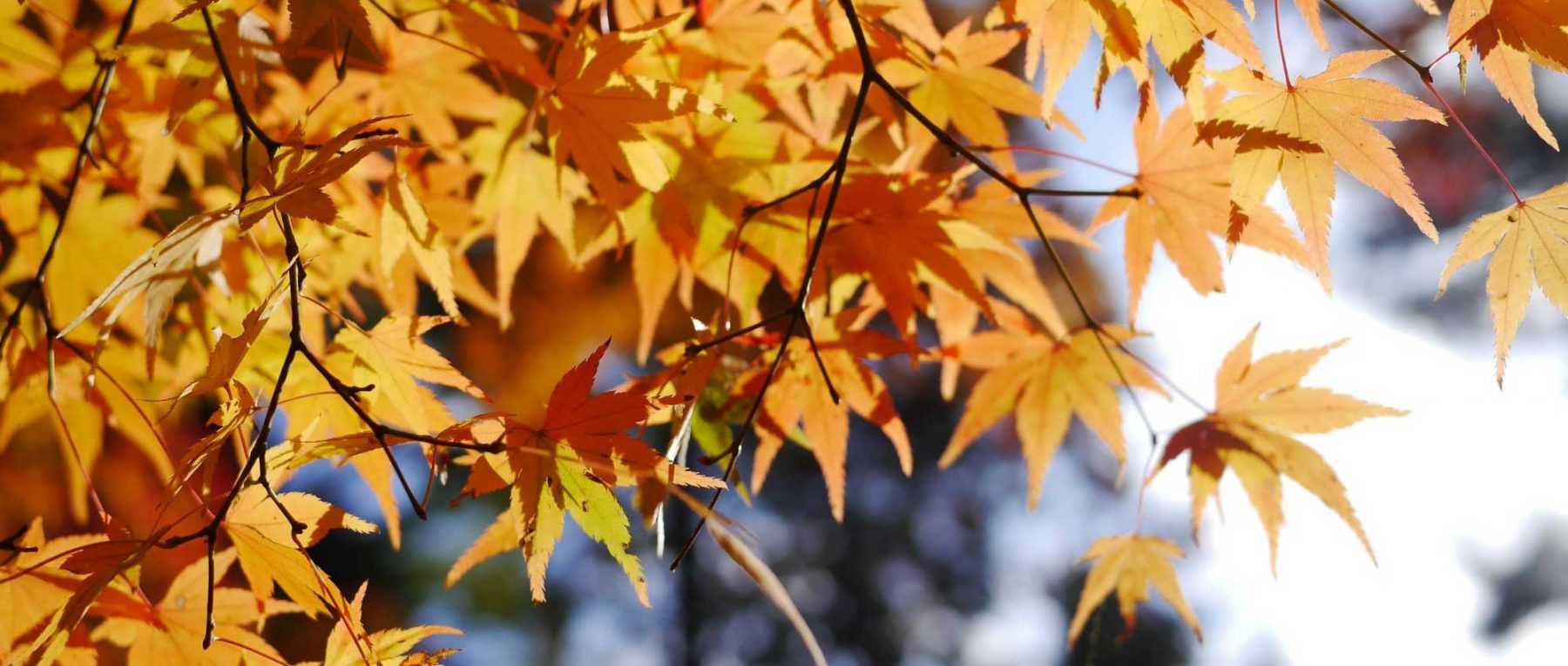
Japanese Maple: Planting, Pruning and Care
Contents
The Japanese Maple in a Few Words
- The Japanese maple is an elegant shrub, with perfect architecture and incredible graphic appeal!
- Its finely dissected foliage takes on stunning hues in autumn.
- It’s a key element in Japanese gardens or Zen gardens.
- Japanese maples are perfect for small gardens and can even be grown in containers!
- They look magnificent as standalone specimens, showcasing their impeccable silhouette.
- They prefer partial shade, cool and well-drained soils, and should be sheltered from wind.
Our Expert's Word
Japanese Maples are small trees or shrubs with palmate, divided foliage that changes colour throughout the seasons, displaying magnificent hues in autumn! They mainly include Acer palmatum and Acer japonicum, as well as the many varieties derived from them. They can be grown in pots and even pruned into bonsai trees! Their foliage astonishes with its incredible delicacy and often bursts into fiery shades in autumn, just before disappearing for winter! Their colours—typically purple, red, or orange—draw the eye in the garden. They brighten shady corners and play with the light. When planted as a standalone specimen, their striking silhouette impresses with natural elegance. The different varieties boast increasingly beautiful foliage, offering remarkable diversity in shape and colour!
Japanese Maples are rather demanding shrubs that require ideal growing conditions to reach their full potential: partial shade, consistently cool and well-draining soil, porous, slightly acidic substrate… Once established, maintenance is minimal—just occasional watering during dry spells (except for potted specimens, which need more regular watering) and periodic compost and mulch at the base. Vigilance against diseases like verticillium wilt is crucial, as they can cause severe damage. Unless you’re aiming for a specific style, such as bonsai or niwaki, Japanese Maples require little to no pruning. These slow-growing small trees are perfect for compact gardens or container cultivation. Ideal for urban gardens, they pair beautifully with ferns and ornamental grasses and fit seamlessly into Japanese-inspired zen gardens.
Botany
Botanical data
- Latin name Acer palmatum, Acer japonicum
- Family Sapindaceae
- Common name Japanese Maple
- Flowering between April and June
- Height up to 10 metres
- Exposure partial shade
- Soil type rich, slightly acidic, moist and well-drained
- Hardiness generally between -15 and -20°C
Japanese Maples are magnificent deciduous trees or shrubs. In France, there are 9 species of maples, but between 110 and 160 exist worldwide. Japanese Maples mainly include the species Acer palmatum, Acer japonicum and Acer shirasawanum, along with the hundreds of varieties derived from them. The Acer palmatum originates from China, Korea, Japan and Taiwan, while the Acer japonicum and Acer shirasawanum come mainly from Japan. The Acer palmatum can be found at altitudes of up to 1,000 metres, primarily in forests and wooded areas.
Maples now belong to the Sapindaceae family, though they previously had their own family, the Aceraceae. The Sapindaceae family includes thousands of species (mostly trees and shrubs), among which are Horse Chestnuts (Aesculus hippocastanum) and Lychees.
Japanese Maples have a beautiful, rounded yet highly graphic architecture. They grow slowly, making them suitable for small gardens or container cultivation, though they can still become quite large. Most Japanese Maples can reach a maximum height and spread of 10 metres. Some, however, grow up to 15 metres tall in their natural state. Their trunks are usually branched from the base. Their slow growth and superb architecture make them excellent candidates for bonsai training. The branches are flexible, sometimes weeping, giving them an almost pendulous or dome-shaped habit, as seen in Acer palmatum ‘Dissectum Garnet’. The Acer palmatum ‘Sangokaku’ surprises with its stunning bright red twigs.
Japanese Maples have exceptional foliage, offering infinite variations in both shape and colour! It changes with the seasons, displaying magnificent hues in autumn. The foliage is deciduous, disappearing in winter. The leaves are opposite, arranged in pairs along the branches.
Maple leaves are palmate. This is what gave the species name to Acer palmatum. The Acer shirasawanum has leaves with very rounded edges. The foliage is always highly graphic, sometimes extremely finely dissected! The Acer palmatum ‘Dissectum’ likely has the most delicate leaves.
Japanese Maple leaves typically measure between 5 and 10 centimetres long, but depending on the variety, they can vary in size. For example, the Acer palmatum ‘Butterfly’ has small leaves measuring only 3 to 5 centimetres in length, while those of the ‘Osakazuki’ variety are much larger, reaching 10 to 15 centimetres long.
Maples exhibit great variability in leaf shape: from the lobed foliage of Acer shirasawanum ‘Aureum’ to the finely dissected leaves of Acer palmatum ‘Dissectum’, and including the Fullmoon Maple (Acer japonicum ‘Aconitifolium’). The leaves have an odd number of lobes, often between five and seven, but sometimes up to eleven, particularly in Acer japonicum or Acer shirasawanum.
The diversity in colours is equally exceptional: from golden foliage like that of Acer shirasawanum ‘Aureum’ to the darkest leaves, such as the ‘Bloodgood’ variety, and including vibrant, acid-toned hues: ‘Orange Dream’ or ‘Sangokaku’… There’s even a maple with variegated foliage, edged in creamy white or pink: Acer palmatum ‘Butterfly’. It’s rare for trees or shrubs to offer such diversity in foliage colour!
Japanese Maple foliage has the advantage of changing colour throughout the seasons! They often display soft, sometimes acid-toned hues in spring (light green, pink, orange, lemon yellow), becoming slightly darker in summer, and finally bursting into fiery colours in autumn! Japanese Maples offer a rainbow of colours, leaving no room for monotony.


Japanese Maple leaves offer a beautiful palette of colours! From left to right: Acer shirasawanum (photo André Abrahami), Acer palmatum ‘Orange Marmalade’, Acer palmatum ‘Red Pygmy’, Acer palmatum ‘Atropurpureum’ and Acer japonicum ‘Aconitifolium’
Some have very beautiful bark, such as the Acer palmatum ‘Sangokaku’ with its bright red wood.
The Japanese Maple flowers between April and June. The flowers are reddish-purple and grouped in pendulous corymbs (except in Acer shirasawanum, where they are upright). They are rather discreet, being very small.
In late summer, Japanese Maples bear decorative red fruits called samaras. They are also known as disamares since they consist of two seeds joined together, each with a wing. This pair of seeds and wings can travel great distances by catching the wind.
The Japanese Maple has fibrous, rather shallow roots. They tend to stay near the surface and dislike competition with other plants. It needs space around it, and the soil should be worked over a fairly wide area. For container cultivation, choose a pot three to four times the width of the root ball.
The main varieties of Japanese Maples
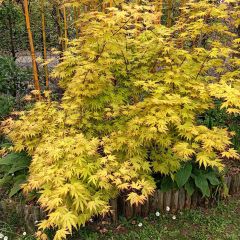
Acer palmatum Orange Dream - Japanese Maple
- Flowering time May, June
- Height at maturity 2 m
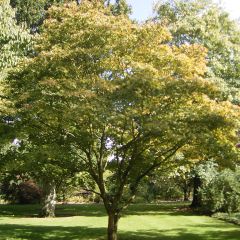
Acer palmatum Osakazuki - Japanese Maple
- Flowering time May, June
- Height at maturity 4 m
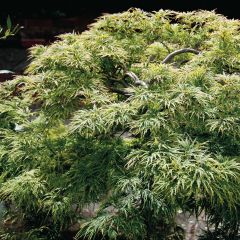
Acer palmatum Dissectum - Japanese Maple
- Flowering time May, June
- Height at maturity 1,60 m
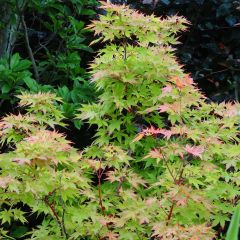
Acer palmatum Sangokaku - Japanese Maple
- Flowering time May, June
- Height at maturity 3 m

Acer shirasawanum Autumn moon - Japanese Maple
- Flowering time May, June
- Height at maturity 3 m
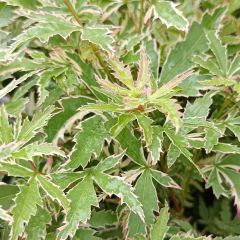
Acer palmatum Butterfly - Japanese Maple
- Flowering time May, June
- Height at maturity 2,50 m
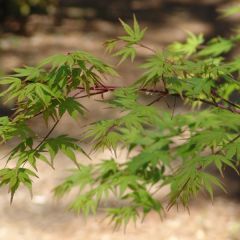
Acer palmatum - Japanese Maple
- Flowering time May, June
- Height at maturity 6 m
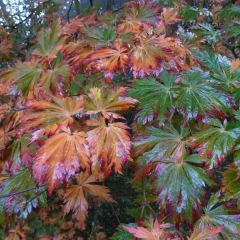
Acer japonicum Aconitifolium - Japanese Maple
- Flowering time May, June
- Height at maturity 3 m

Acer shirasawanum Aureum - Japanese Maple
- Flowering time July, August
- Height at maturity 4 m
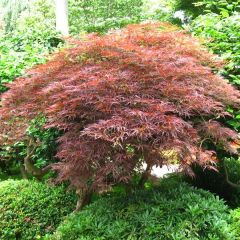
Acer palmatum Dissectum Garnet - Japanese Maple
- Flowering time May, June
- Height at maturity 3 m
Discover other Japanese Maples
Planting the Japanese Maple
Where to plant?
We recommend planting your Japanese maple in partial shade. Full sun could cause leaf scorch in summer, while deep shade would make its autumn colours less vibrant and spectacular.
Plant it in fresh but well-drained soil! Waterlogged soil encourages fungal diseases like verticillium wilt. If your soil is heavy or clay-based, improve drainage by adding gravel or coarse sand when planting. You can also plant it on a mound or slope to help water run off.
Japanese maples prefer slightly acidic soil. They thrive alongside other ericaceous plants like azaleas, Japanese andromeda (Pieris japonica), or daphnes.
Choose a sheltered spot, protected from cold or drying winds. Avoid planting too close to other trees or shrubs, as they dislike root competition.
They appreciate organic-rich soil. We recommend adding well-rotted compost at planting time.
Finding the perfect spot for your Japanese maple is crucial. This delicate plant is more prone to diseases and pests if conditions aren’t ideal. If your garden isn’t suitable, you can grow it in a container on a patio or terrace.
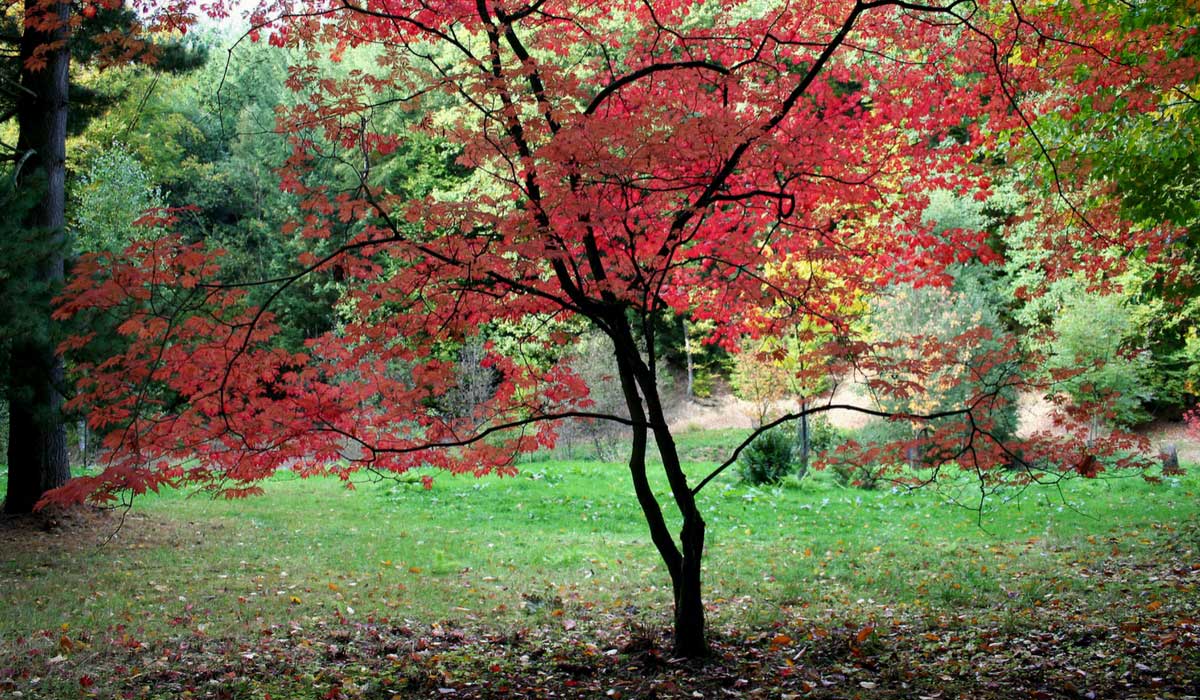

Plant Japanese maples in partial shade. Here, Acer japonicum ‘Aconitifolium’ (photo Jean-Pol Grandmont)
When to plant?
Plant your Japanese maple in autumn for best establishment. In wet regions, however, spring (March–April) is preferable.
How to plant?
- Soak the root ball in water for about 15 minutes.
- Dig a planting hole three to four times wider than the root ball, as Japanese maples have shallow, spreading roots.
- Add well-rotted compost, ericaceous soil, and gravel or coarse sand for drainage.
- Plant at the same depth as the root ball, ensuring the graft union remains above soil level.
- Backfill and gently firm the soil.
- Water thoroughly.
- Apply mulch to retain soil moisture in summer.
Japanese maples also thrive in containers—choose a wide pot with drainage holes. Add a layer of gravel or broken pottery at the base, then use a mix of garden soil, compost, pine bark, and clay pebbles. Plant, backfill, firm, and water. Container-grown maples need more frequent watering as they dry out faster.
For detailed planting guides, check out:
“Japanese Maple: Planting Success” and “Japanese Maples in Pots: Selection, Planting & Care” and Which Japanese Maples Can Be Grown in Pots?
Maintenance
The Japanese maple is a delicate tree that is easily affected by diseases if not planted in suitable conditions. Careful attention is needed to ensure its longevity. As it thrives in rich, light soils, it will benefit from an annual application of well-rotted compost. The leaves of Japanese maples can sometimes be scorched by summer sun or late spring frosts. In colder regions, you can apply a layer of mulch around the base of your maples in autumn to protect them from the cold. If grown in pots, wrap them in winter fleece. We also recommend repotting your Japanese maples every two to four years. Do this in late winter, just before new growth begins.
Japanese maples need cool conditions, which is why it’s important to water them during summer and dry spells. However, they dislike excessive moisture—strike a balance and allow the soil to dry slightly between waterings. Extra vigilance is needed for potted specimens to prevent water stress. Mulching helps retain soil moisture. Young trees require more frequent watering, becoming more resilient as they mature. Avoid using hard water; rainwater is preferable. In summer, mist the foliage in the evening to cool the tree and deter spider mites.
Japanese maples are highly susceptible to verticillium wilt, a soil-borne fungal disease that thrives in heavy, damp soils. Leaves wilt, branches gradually die back, and the tree often perishes. There’s no cure, only prevention—starting with good drainage. For details, read our guide Japanese Maples: Beware of Verticillium Wilt!
Coral spot disease (Nectria cinnabarina) may also infect Japanese maples. This fungus spreads, killing twigs and leaving orange pustules on branches. Prune affected parts to curb its spread.
Honey fungus (Armillaria mellea), or root rot, is another threat. This fungus decays roots and the trunk base, causing rapid leaf wilt and branch dieback.
For all fungal diseases, remove and burn infected branches to limit spread. Always sterilise pruning tools.
As for pests, Japanese maples may be attacked by defoliating caterpillars, which weaken the tree by devouring leaves. Cut away and burn infested sections. For severe infestations, use garlic spray or Bacillus thuringiensis. Mealybugs (recognisable by white, cottony patches) and aphids (especially on young spring foliage) also target these trees. Both sap-suckers excrete honeydew, encouraging sooty mould. Treat with a mix of black soap, rapeseed oil, and diluted rubbing alcohol. Nettle tea works against aphids. Spider mites can be deterred by regular leaf misting.
For identification and treatment tips, explore our guide: “Japanese Maples: Diseases and Pests”
If your Japanese maple shows no signs of disease, avoid pruning. It stresses the tree, and wounds invite infections like verticillium wilt. These slow-growing shrubs may stall further if cut. Refrain from pruning young specimens; let them develop naturally for several years. To reshape or balance the tree, prune in winter (November–February) during dormancy, avoiding frosts. Dead branches can be removed in the growing season for easier spotting. Sterilise tools and apply wound sealant.
For expert pruning advice, see: “Japanese Maple Pruning: Maintenance, Bonsai, or Niwaki”
Propagation
Japanese maples can be propagated by seed, cuttings or grafting. We recommend taking cuttings, as this will ensure you obtain a plant identical to the original variety. However, some varieties are difficult to propagate using this technique.
Seed Propagation
Japanese maple seeds require a cold period to break dormancy and enable germination in spring. They must therefore be stratified by placing them in the refrigerator for several months before sowing in pots. Seed propagation is best suited for species types, such as Acer palmatum.
- Collect the seeds in autumn.
- The seeds are attached to a wing. You may detach it to make sowing easier.
- Fill a tray with moist sand and mix the seeds into it. Seal the tray in a plastic bag and place it in the vegetable drawer of the refrigerator for at least three months. Alternatively, you can use an airtight container instead of the tray and plastic bag.
- Once the seeds begin to germinate, remove them gradually for transplanting.
- Prepare pots with a mix of compost, sand and a little ericaceous soil.
- Transplant the young seedlings into these pots.
- Water them.
- Place the seedlings in a sheltered spot away from direct sunlight.
Propagation by Cuttings
You can propagate Japanese maples from softwood cuttings in early summer, around June. However, some varieties are difficult to reproduce using this method. The species type, Acer palmatum, roots quite well from cuttings.
- Fill a pot with a mix of compost and perlite or coarse sand, moisten it, then gently firm it down.
- Make a hole with a pencil or wooden stick.
- Take a healthy stem cutting from the current year’s growth, about 15 cm long. Make a clean cut just below a node (where leaves emerge), using a sterilised tool.
- Remove the leaves from the lower part of the cutting, leaving only two or three at the top.
- Optionally, dip the base of the cutting in water, then in rooting hormone to encourage root development.
- Make a hole in the growing medium with a pencil or stick, then insert the cutting.
- Press the medium around the stem to ensure good contact and eliminate air pockets.
- Place the pot in a bright location but out of direct sunlight, ideally at a temperature of 20-25°C.
- Mist the cutting several times a day to prevent it from drying out. You can also cover the pots with a plastic bag to maintain humidity. The bag should have holes and be removed occasionally to prevent fungal growth.
- Water regularly. The growing medium should stay moist but not waterlogged.
Grafting
Commercially available Japanese maple varieties are often grafted. Seed propagation does not guarantee an identical plant to the parents, and some varieties are very difficult to propagate from cuttings. Grafting then remains the only effective method for these varieties.
The best time to graft is in late winter (February–March) or July–August. Ideally, use Acer negundo or Acer palmatum as rootstock. Select the variety you wish to propagate as the scion.
Japanese maples are preferably grafted using the whip-and-tongue method. Take a scion around 15 cm long and cut the base at a slant. Make a matching cut in the rootstock, just above the crown, then insert the scion and secure it with grafting tape. Apply grafting wax to aid healing and prevent disease. Once the scion has taken, you can remove the rootstock above the graft.
Alternatively, you can perform a bud graft (chip budding) in early spring or August.
Association
Japanese maples are perfect for creating a zen garden, a very restful garden with Japanese inspiration and a predominantly mineral theme. Plant bamboos, Cornus kousa or azaleas. Add small plants like mosses, grasses and mondo grass. Include some cloud-pruned shrubs, such as Pinus sylvestris.
Since maples prefer slightly acidic soils, they naturally pair well with other heathland plants! Enjoy the blooms of Kalmia latifolia, azaleas or daphnes, as well as the decorative, red-tinged foliage of Japanese andromeda, Pieris japonica.
The Japanese maple is particularly well-suited to urban gardens. Create a contemporary garden, for example by placing it in a patio, planted in a container amidst a predominantly mineral and graphic setting. Add some ferns, grasses or mondo grass.
Don’t hesitate to plant your Japanese maple alongside other decorative foliage plants: hostas, heucheras, ferns, grasses… Enjoy the stunning golden foliage of Hakonechloa macra ‘All Gold’. Japanese maples always pair beautifully with ferns! Perhaps because these plants share a natural elegance and graphic quality. They impress us with the delicacy of their foliage, creating a sense of lightness and freshness.


Acer palmatum ‘Garnet’ with Hosta ‘August Moon’, Heuchera ‘Pinot Noir’ and Blechnum spicant (Copyright GAP Photos-Sarah Cuttle), Heuchera ‘Marmalade’, Acer palmatum, Dryopteris cycadina.
You can play with colours, for example by creating warm-toned beds with Acer palmatum ‘Sangokaku’, Heuchera ‘Marmalade’ and Persicaria runcinata ‘Purple Fantasy’. Take advantage of the maple’s fiery foliage to compose a stunning autumn scene! Plant alongside it species like Eupatorium maculatum ‘Atropurpureum’, Sedum spectabile, some dahlias, Cornus alba ‘Sibirica’ or crape myrtle (Lagerstroemia indica), whose foliage takes on beautiful autumn hues. Don’t hesitate to highlight your maple’s colourful foliage among darker-toned plants, for example by planting Acer shirasawanum ‘Aureum’ next to Heuchera ‘Obsidian’ or Sambucus nigra ‘Black Lace’… You’ll achieve a striking contrast!
Need a little extra inspiration? Check out our advice sheet: “Japanese Maples: 9 Successful Planting Combinations”
Did you know?
- An autumnal spectacle in Japan!
In Japan, there is a tradition of admiring the spectacle of leaves turning into vibrant autumn colours, particularly those of Japanese Maples. This custom is called momijigari (momiji meaning Maple). The period when these leaves change colour is known as kôyô. The best place to admire them is in the Kyoto region, especially in certain temples. The maples are often illuminated to highlight their colours at night.
Useful resources
- Our wide range of maple trees, including many Japanese maples
- An article by Michael on our blog: Japanese Maples: Beware of Verticillium Wilt!
- Two videos explaining how to stratify Japanese maple seeds, then how to transplant them
- Our advice sheets:
- Read our Japanese maple advice sheets by leaf colour: 6 Japanese maples with green leaves, 7 Japanese maples with red leaves, Japanese Maples: The Most Beautiful Autumn Colours
Frequently asked questions
-
The foliage of my maple is drying up and falling off!
It is likely suffering from a lack of water. Japanese maples cannot tolerate drought. Water during dry periods and mulch to keep the soil cool. Be very vigilant with watering, especially during the first few years. Later, the shrub becomes slightly more resilient. Similarly, if grown in containers, the compost will dry out quickly, requiring regular watering.
This could also be a sign of verticillium wilt, a fungal disease transmitted through the soil. Unfortunately, there is no cure, only preventive measures such as ensuring proper soil drainage when planting.
-
The branches of my maple tree have large black spots and are drying out. What should I do?
This is likely verticillium wilt, which causes branches to die off one after another. Unfortunately, there is no effective treatment for this disease. Remove and burn affected parts immediately to limit its spread. We also recommend thoroughly disinfecting pruning tools. Reduce watering, especially if your maple is planted in the ground, and allow the soil to dry out between waterings, as moisture encourages the development of this disease.
-
The foliage shows signs of scorching!
Your maple tree has likely been exposed to direct sunlight. It's best to plant it in partial shade, preferably beneath deciduous trees. The lighter-coloured foliage is the most sensitive and more prone to scorching than maples with darker leaves.
-
The autumn foliage is not exceptional, the colours are dull.
This happens when maples are planted in too dense shade... the leaf colours fade! As with moisture, you need to find the right balance: a bright location but without too much direct sunlight. Partial shade is the ideal exposure for them.
-
My Japanese maple isn't growing!
These are slow-growing trees and shrubs. Be patient. Otherwise, your soil may be too compact, which limits their development, or the substrate may not be rich enough! We recommend adding compost once a year.
- Subscribe!
- Contents



































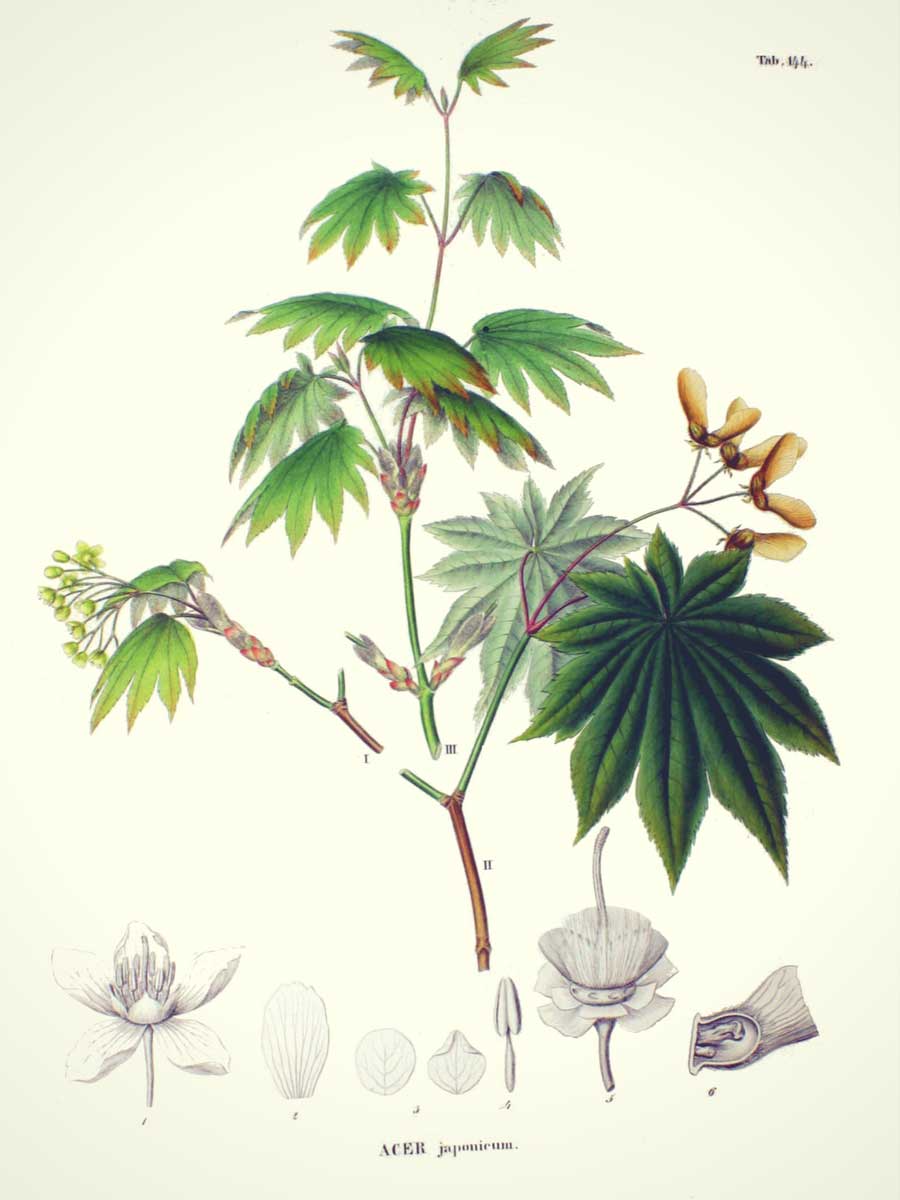
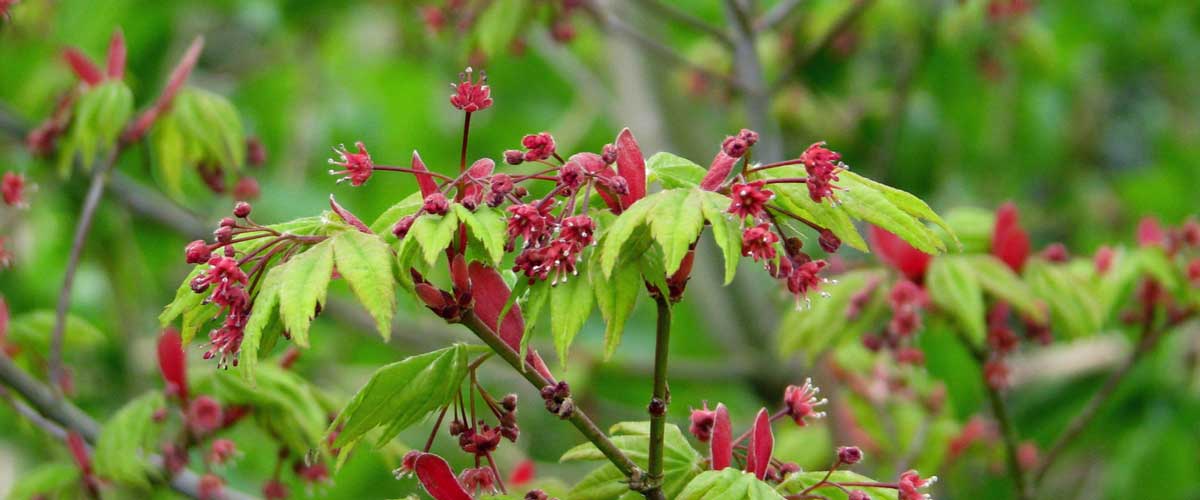
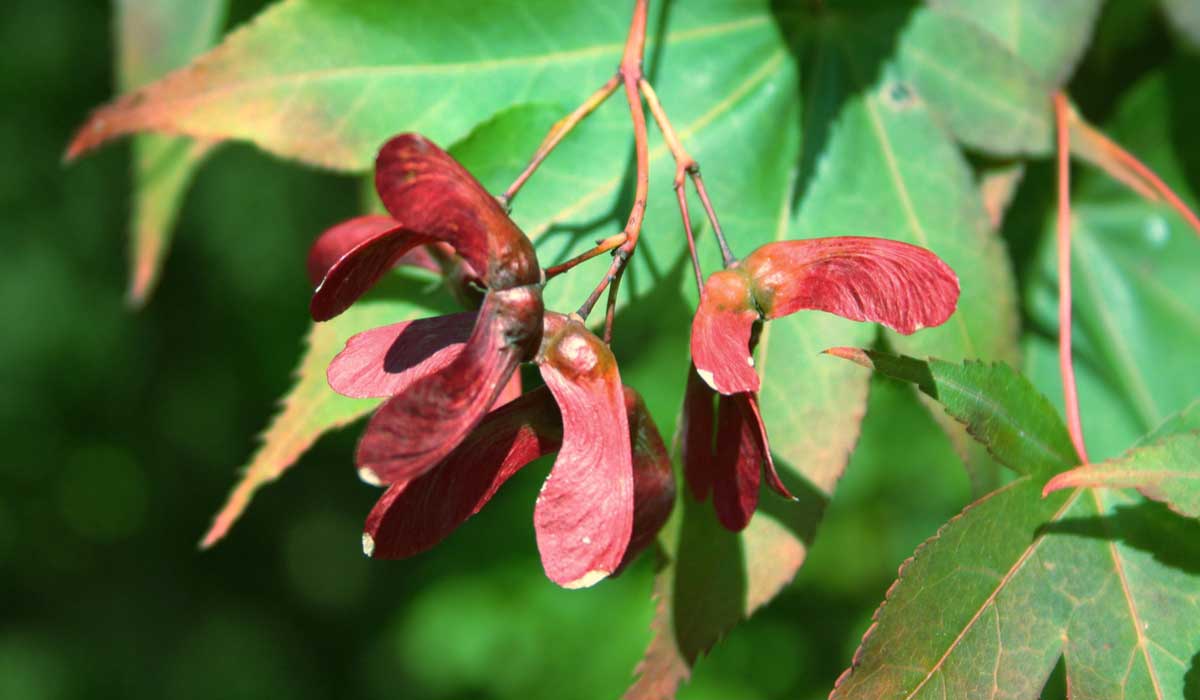
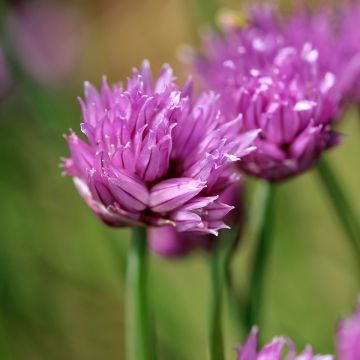


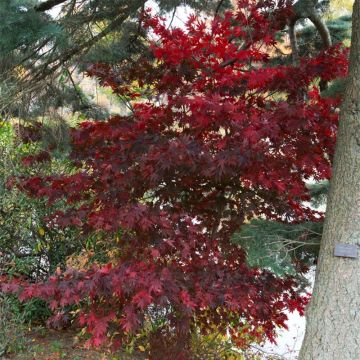


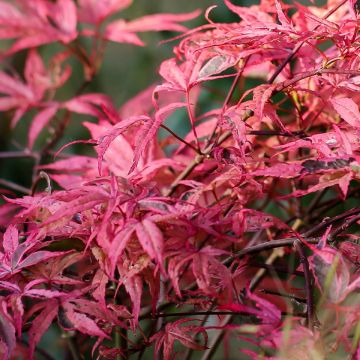
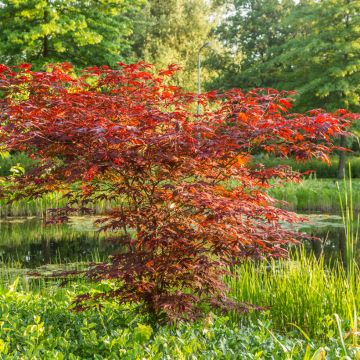
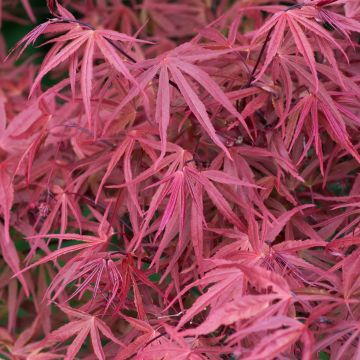


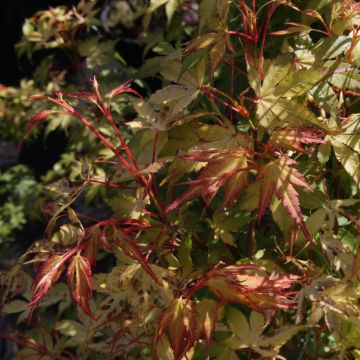
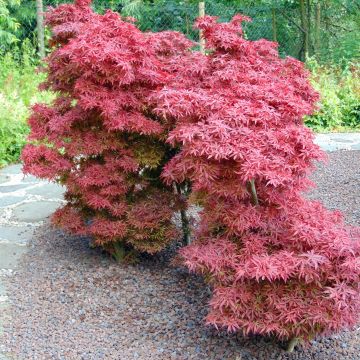

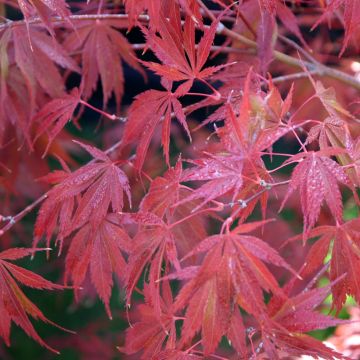
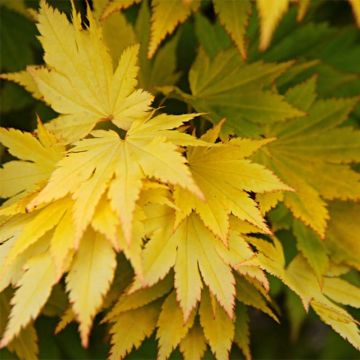

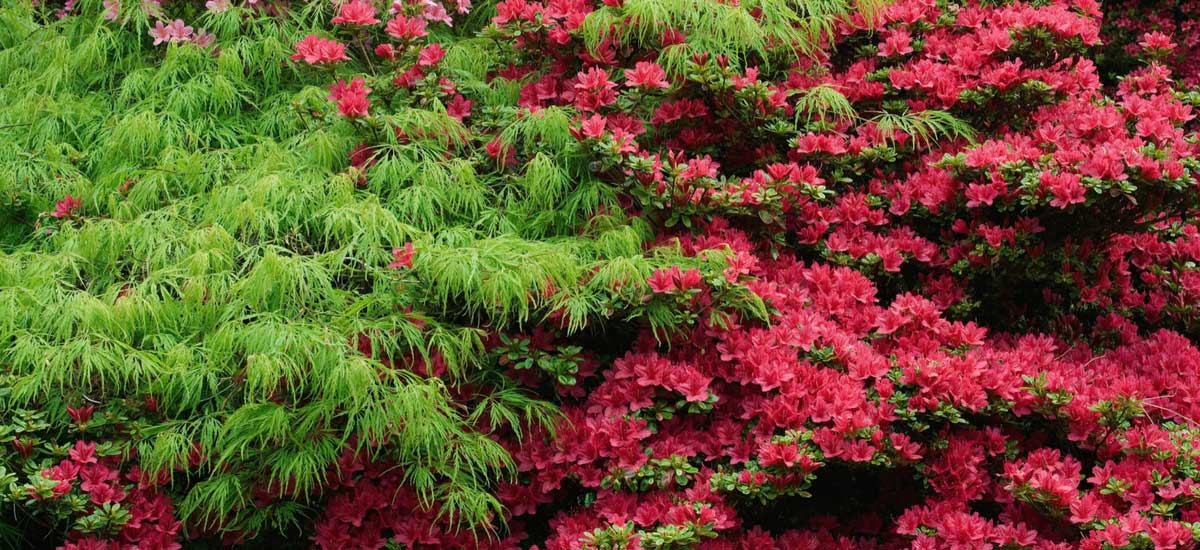
Comments